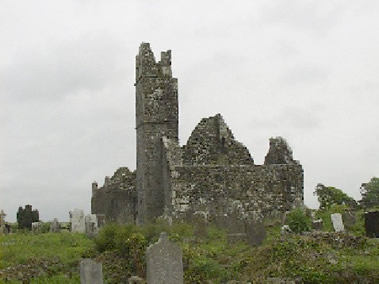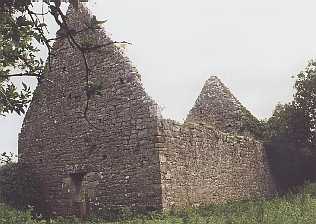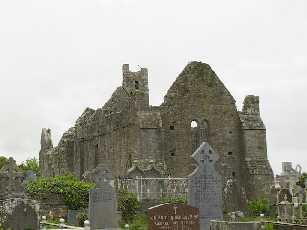
© Ruins on the site of St Nessan's monastery
St Nessan founded the monastery in Mungret. According to
'Limerick, the Rich Land', the monastery had six churches and 1500 monks.
The abbey was founded in the 6th century. The monastery was plundered
on several occasions throughout its existence, three times in the ninth
century by the Vikings and once by a local chief Murtagh O'Brien in 1107.
In 1179, the King of Munster, Donal Mór O'Brien, granted the monastery
and its lands to the Bishop of Limerick, Brictius. The monks of Mungret
Abbey were the Canons Regular of the Order of Augustine in the 12th century
onward.
According to the Psalter of Cashel, this monastery had six
churches within its walls. The Psalter of Cashel disappeared from Cashel
after Murrough O'Brien attacked Cashel in 1647.
Extensive ruins remain today, although nothing remains of
the original 6th century monastery. These include a small 12th century
church, and a ruin known as 'the Abbey', which consists of the nave and
chancel of the church. Burial grounds surround all of the ruins.

© Oldest church ruin
The oldest church ruin is located in the smallest section
of the graveyard, across the road from the main graveyard. This church
is believed to have originated between 800-1100.

© Ruin of St Nessan's church
St Nessan's church is believed to have been built before
1100. It is located on the left of the road from Limerick. This ruin is
covered by ivy. The oldest of the three abbey building is by the roadside.
The window on the east side is from the 12th century but the church dates
from the 10th century.

© The 'Abbey' ruin
The largest of the ruins is that of the Abbey. It was built
between 1251 and 1272. The ruin is divided into three parts, the chancel
to the east, which dates from the 13th century, the nave in the centre,
the date of which is unknown, and the western portion of the ruin, which
dates from the fifteenth century. There is a tower on the northern side
of what was once the priests' residence.
The Abbey was used as a Protestant church until 1822. The Board of Works
carried out repair work on the ruins in 1932. The surrounding graveyard
is still in use and has been extended in the past 25-30 years.
Mainchín Seoighe relates an interesting story about the Wise Women
of Mungret. Mungret was renowned as a monastic school and seat of learning.
A contest had been arranged between Mungret and another famous monastic
school, to decide which monastery had the more learned scholars. The visiting
monks were from Lismore in Co. Waterford.
The monks of Mungret, not wishing to be defeated in the contest, devised
a plan to intimidate the opposition. A number of them dressed up as women
on the day of the contest, and began washing clothes near a ford that
the other monks would have to cross. One of the monks asked a washerwoman
for directions to the monastery in Irish. The 'washerwoman' replied in
flawless Latin. A second 'washerwoman' gave more information in flawless
Greek. The monks decided that if the washerwomen were fluent in Greek
and Latin, then the learned scholars of the monastery would surely defeat
them in the contest. They returned home, leaving Mungret monastery unchallenged.


|